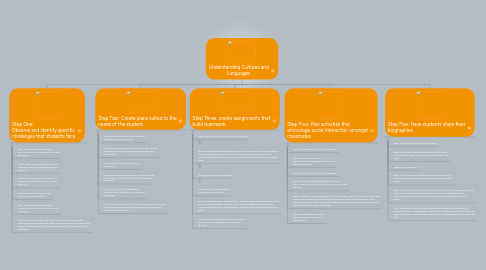Understanding Cultures and Languages
저자: Chris D


1. Step Two: Create plans suited to the needs of the student.
1.1. Who: The students who are in need of assistance, and the teacher.
1.2. What: Differentiated plans that might best suit the student’s personality, based on observation and interaction.
1.3. Where: Classroom, school yard, or homework.
1.4. When: When the teacher has collected enough information on the student to make informed decisions.
1.5. Why: To best help the student by targeting their strengths, weaknesses, and needs.
1.6. How: Using a multitude of activities to engage the student in as many ways as possible. Using visuals, audial, and kinesthetic stimulation.
2. Step One: Observe and identify specific challenges that students face
2.1. Who: Students who might have difficulties with cultural adaptation and their peers.
2.2. What: Understand difficulties that the student faces, both academically and socially.
2.3. Where: In the classroom, cafeteria, or social areas. Where possible, consult parents.
2.4. When: As soon as students are introduced to the setting.
2.5. Why: To best help the student by targeting their strengths, weaknesses, and needs.
2.6. How: Interact with the student and learn as much as possible, observe how their peers treat them and how they interact with their peers, see how they react to certain exercises and activities in the classroom.
3. Step Three: create assignments that build teamwork
3.1. Who: The student, their peers, and the teacher
3.1.1. Dependencies
3.1.2. Milestones
3.2. What: Assignments that require students to work in teams to find solutions. These assignments should focus on academic achievement, but the achievement should be the result of successful cooperation of the student team.
3.2.1. Schedule
3.2.2. Budget
3.3. Where: School or home setting.
3.3.1. KPI's
